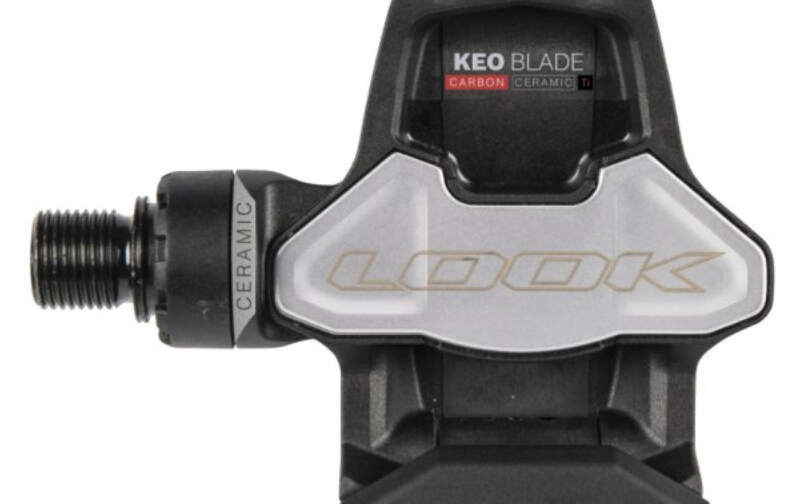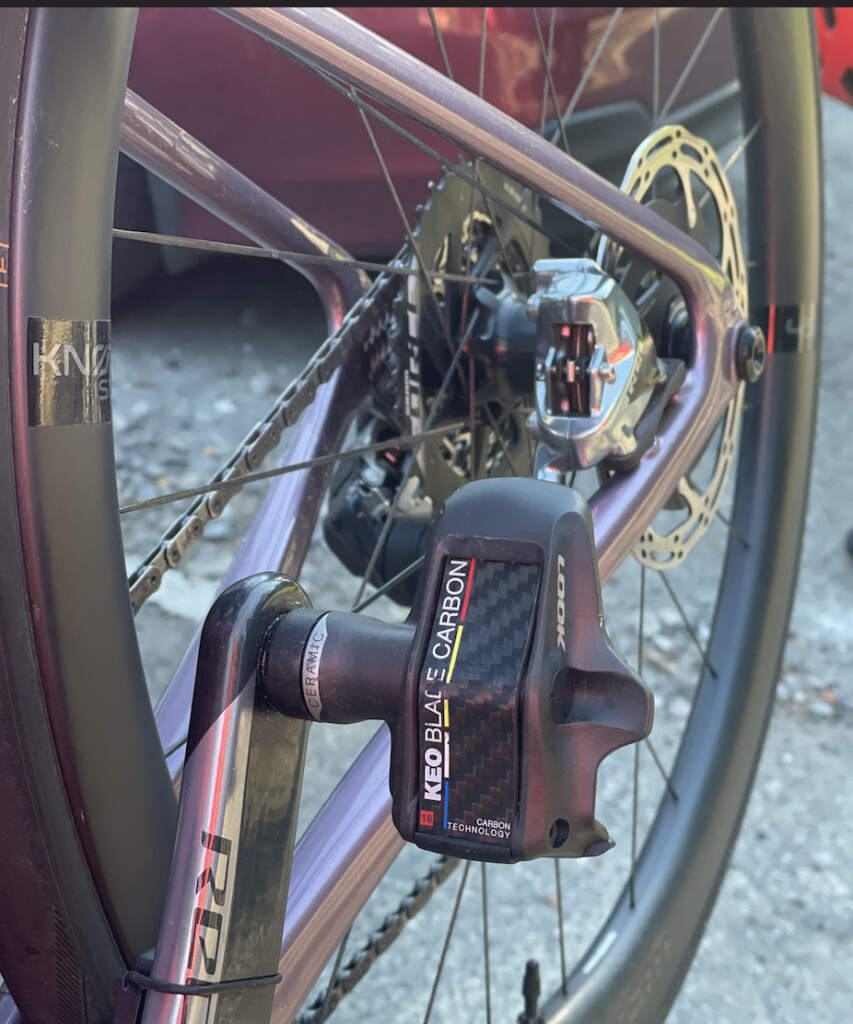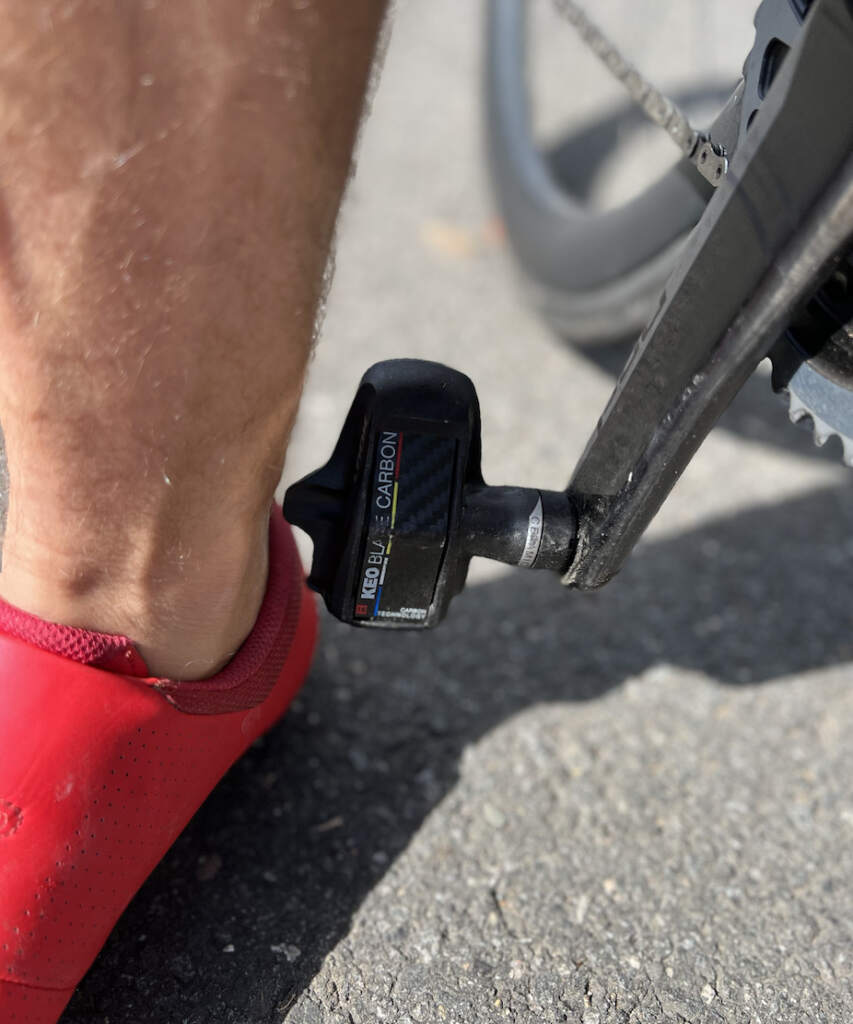
LOOK Keo Blade Carbon Ceramic Ti Pedals are reviewed in this post and ask the question…
Do the “marginal gains” provided by ultra-smooth ceramic bearings make these top-end pedals worth the ultra-high price?
When Look invented the clipless pedal in 1984, adoption of the new gear had a rocky start. Before Look’s clipless pedals, which are a modification of ski bindings of the era, cyclists affixed their shoes to their pedals with a bolt or cleat and then secured their shoes even more by wrapping a strap around the shoe and the pedal,
Nowadays, it’s nearly impossible to find anyone from the advanced enthusiast to the professional rider that rides without clipless pedals. For many riders, moving up to clipless pedals marks their actual entry into the next level of cycling.
Look’s Keo Blade Carbon Ceramic Ti pedals represent the current pinnacle of technology from the legendary French company. Still, even their marketing literature admits that they provide “marginal gains” over their other pedals, despite the higher-than-average price tag.
The Blade pedals use a single sheet of carbon fiber as a spring, as opposed to a traditional metal spring, which in itself is a significant differentiator from their other offerings, and the ceramic bearings make the pedals turn more smoothly. But do either of these things justify the $400 price point?

LOOK Keo Blade Carbon: As The World Turns
Those first pedals were a monumental shift in technology, a change in the paradigm that had been in place since the beginning of cycling itself. Since then, clipless road pedals have evolved and have become more refined, lighter, and all-around better, but they hadn’t changed much since their launch decades ago. You could easily put an original pair of Look pedals on your bike and happily ride them. (Or at least a pair that had float, which arrived on the scene just a few years after the original pedals.)
Since the 1990’s though, pedals haven’t changed as much. Sure, different systems have come (and some have gone) with advances in technology or tweaks to the binding mechanism (I’m looking at you Speedplay), but largely bike pedals are still a variation on ski bindings, and they feature similar operation.
As a quick refresher, a clipless pedal is generally a mechanical system with two spring-loaded clamps, one on the back and one on the front of the pedal. When a rider presses their cleat into the pedal, the clamp’s jaws slide open, and then when the pedal is far enough in, the jaws close and hook around the pedal. The spring in the pedal allows the binder mounts to open, which is the key to the system. Different systems use different springs, many of which are tuneable to a rider’s preference (to some degree) for the amount of force needed to engage and disengage from the pedals.
The Look Blade system uses a flexible piece of carbon fiber as the spring, which has some benefits and some drawbacks. The carbon material has specific properties that are consistent every time the cleat is engaged, so you always know how much pressure to apply. When activated, the mechanism provides a resounding click, so you know when you’re in (and everyone around you knows as well).
Look states that the profile of the Blade pedals is more aerodynamic, more stable, and has the best weight-contact surface area of any pedal. While I don’t have the skills or time to measure every pedal on the market, this seems very likely accurate.

The downside of the carbon fiber spring is that it’s not tuneable. To change the pressure required to clip in, it’s necessary to replace the carbon spring with another one, one designed to take different input pressure.
It’s a very specific solution to the problem of clipping in compared to a tunable spring, and it assumes that someone who uses this system is comfortable with clipping in and prefers the security of this technology over the ease of entry/exit. It is, in other words, perfect for the distance cyclist or racer, someone who doesn’t have to clip in and out at every stoplight.
These are my favorite in my few hundred miles with these pedals (which I’m comparing to the thousands of miles I’ve ridden other Look pedals). I tried the Blade system years ago and didn’t like it, though part of that was because I ran a lot of group rides that had frequent stops at lights, and getting out of the pedals in a quick stop was sometimes tricky.
But now I love the carbon blade technology. With a lot of traffic noise around me on some rides, hearing and feeling the positive engagement means that I always know if I’m clipped in or not. I love the solid feeling and the stiffness of the pedals, and I’m likely never going back to traditional spring models.
The carbon spring is an acquired taste, and not all riders will like it, so if possible, find a shop that will let you test them first. But the system works flawlessly, and like all Look Keo pedals will provide thousands and thousands of miles of dependable riding.
If you’re trying to decide if you should go with the traditional pedals or switch to the Blade pedals, I highly recommend the carbon spring system. I think it’s an improvement over the conventional design, and the benefits are many.
But Why The Blade Carbon Ceramic Ti?
With two ceramic models in Look’s lineup, the first question is, “why ceramic?” Unlike metal bearings, ceramic bearings are incredibly smooth, which reduces friction. Look claims an 18% reduction in friction for ceramic bearing pedals relative to the metal bearings. Whether or not that’s noticeable on the ride, it’s still a better solution with performance benefits. Today’s ceramic-bearing bottom brackets are a testament to the real-world performance of ceramic bearings.
We’ve established the why of carbon-fiber-based pedals, but what’s the why for these pedals. The lowest-priced Blade pedals, the Keo Blade Carbon are $165, and the middle-level model, the Carbon Ceramic is $250. Why spend $400 on pedals when very similar options are available for hundreds less?
The ceramic pedals certainly make sense relative to the standard Blade Carbon. There’s only an $85 price difference, yet ceramic bearings are smoother and last longer than standard bearings. Since pedals rotate more than any part of your bike (besides a hub), the smoother the action, the smoother the ride.
The Look Keo Blade pedals are already very light, with the heaviest Blade coming in at 115 per pedal for a total of 300g for pedals and cleats. The Blade Carbon Ceramic comes in at 290g for pedals and cleats, a very modest weight saving.
The Look Keo Blade Carbon Ti tips the scales at…260g for pedals and cleats. For those not good at mental math, that’s 40 grams of weight savings from the Look Keo Blade Carbon to the Look Keo Blade Carbon Ceramic Ti. That’s about $5.70 per gram.
In case you’re thinking, “surely though that must be a lot lighter than Look’s standard spring-based pedals,” let me assure you that it’s not. The least expensive Look pedals, the Look Keo Classic 3 and the step-up Look Classic 3 Plus are the same weight, at 350g for the pedals and cleats, and cost $65.
That means that the price difference between the Look Keo Classic 3 and the Look Keo Blade Carbon Ceramic Ti is $335, and the weight difference is 90g, or about $3.70 a gram.
Now you’d think that this would mean that the Look Keo Blade Carbon Ceramic Ti pedals are a no-go, and that’s the case for most users. After all, an empty water bottle is about 100-130 grams.
But this bit of mathematical analysis says a few things to me. First, the two lower models of the Keo Blade are a good deal if you buy into the idea of a carbon spring, and based on dollars alone; they’re a much better value.
It also says that the company has focused on making products for all price points, with a very similar feel and functionality. For $65, one can get a pair of solid, dependable pedals and enter the world of clipless road pedals, and as that rider levels up, transition—if they want—to products with some additional benefits without breaking the bank.
So now we come to the bank-breaking. Why does the Look Blade Carbon Ceramic Ti exist if it’s just slightly lighter than its siblings?
The answer is the same as “why are there $300 bike jerseys when there are also $50 bike jerseys?” Because there are people who will spend any amount of money to get the pinnacle of a product or who want the status of using the most expensive product.
This isn’t a bad thing. Many of the super-expensive jerseys have a better manufacturing process or better quality materials. Many of them have features not found on lower-cost jerseys. And if someone is willing to spend top dollar to get the best of something, even if there are diminishing returns, then having that product available is a win for everyone.
No matter the rider, there’s a Look Keo pedal available to suit their needs. If you’re a budget-level rider or price-conscious, get the $65 or $80 pedals. If you want the best return-on-investment, get the pedals in the $150-250 range. If you’re going to ride the best of the best, there’s nothing that beats the Look Keo Blade Carbon Ceramic Ti pedal.
…We're riding townies, adventure, and mountain bikes. Find recommendations on our store page. As Amazon Associates we earn from qualifying purchases.